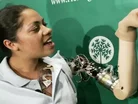Prosthetic limbs- a marvel and a blessing

Our bodies are things that we easily take for granted. But there are numerous others who suffer from physical disabilities and ailments, and some others may encounter severe, life threatening injuries and accidents. In many cases, patients need to have their limbs amputated. Prosthetic limbs have come as a relief to numerous people.
Prostehtic limb is an artificial device that replaces a missing body part. Biomechatronics is the science of using mechanical devices with human skeleton, muscles, nervous systems and other physical aspects to help a person with enhanced motor skills and help in mobility. Common prosthetic devices include hearing aids, artificial valves for the heart, artificial foot and hands.
However, the idea of prosthetic limbs has been there since ancient times. References have been found in old civilizations and histories of men who have lost limbs and have them replaced or fitted by mechanical devices and even weapons. There are also archeological discoveries of old prosthetic body parts.
However, in modern times, many researchers and health officials have helped develop the technology. Medical advancement and interest grew markedly after the Second World War, and various governmental and private entities and organizations have emerged which provide research and help people who need or have prosthetic limbs and devices.
A medical wonder
Mainly, prosthetics can be divided into two types: upper extremity prosthetics and lower extremity prosthetics. Most common cases involve losing the whole or parts of one’s arms or legs.
While ancient prosthetic devices were heavier, modern biomechatronics has been benefitted greatly by advances in plastic technology and carbon-fiber composites. Modern limbs are lighter, stronger and much more realistic. Advances in electronics technology have also ensured better control over artificial limbs, and some limbs can even automatically adjust to various levels of physical exertion, like walking and running.
A prosthetic limb mainly constitutes of pylon, which is the basic skeleton; the socket, which fits into the joint and the suspension system, which keeps the limb attached to the body. The pylon was earlier made of metal rods, but now, sturdy plastics have replaced them. The pylon may be enclosed in a cover, which can be dyed to match the recipient’s skin tone.
The socket is probably the most crucial part, since it interfaces with the body, and must be carefully fitted. More than often, the sockets come lined with soft protective layers so as the delicate skin and tissues do not get irritated. The suspension system is complex, and differs with each limb, sometimes belts or harnesses are used to hold the limb in place, other times; more commonly, the suction technique is used. However, some limbs are custom made, depending on the needs of the patient.
Physical therapy after getting fitted with a prosthetic limb is very important. Learning to walk with a prosthetic implant can be particularly challenging; and may even take months. With time, it becomes easier to perform everyday tasks with prosthetic limbs. It requires intense coordination with the muscles that are still responding to the patient’s command and the artificial limbs.
In advanced limbs, the limbs often operate by taking its clues from the electrical signals that the muscles send. Some electrodes are placed on the skin that pick up these signals, and in turn, these help to control the prosthetic limbs in a way similar switch control method. Prosthetic limbs that function in this way are called myoelectric.
Offering a support
Apart from the advances in medical science, the modern world is also marked by increased connectivity. Losing a limb, or being born without one is a matter of deep concern and often a source of depression. Patients with prosthetic implants often need psychological help; since getting used to and acquiring the ability to control the limb is a timetaking and emotionally exhaustive process.
Several support groups fortunately are available, who provide a platform for prosthetic limb users and their loved ones to bond and share their experiences with; and these groups also provide help with various other things. The International Society for Prosthetics and Orthotics was founded in 1970 in Copenhagen; and is dedicated to furthering research in this field worldwide. Every three years, an international conference is held and the association also publishes its own journal.
Prosthetic surgery and implants, unfortunately, are very expensive and remain unaffordable to many. However, many governments and non-governmental associations throughout the world work to make them available to people in need.
Triumph of life
People with prosthetic implants have embraced life with greater zeal. The Paralympics mark a triumph of the human spirit. Sgt. Jerrod Fields, an US Army World Class Paralympic sprinter is a below the knee amputee. Reinhild Möller is another icon, who lost her leg in a childhood accident but went on to win multiple medals in ski racing.
People with disabilities are now much outspoken about their lives, and thanks to activists’ efforts, the social stigma related to disability is getting eroded. With prosthetic limbs, people can challenge the inevitability of fate and lead a better life.
Scientists are looking at making more sophisticated limbs, like robotic arms and legs; and prototypes are reportedly in the making and testing stage. Science is looking at making bionic limbs a reality, which will ensure better, smoother operations.



